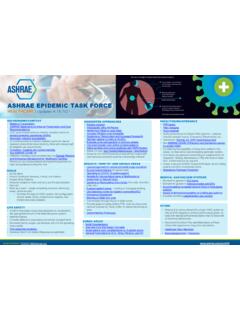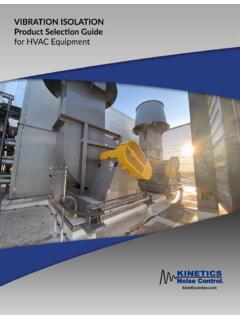Transcription of REGULATIONS & GUIDELINES TO FOLLOW! TJC, FGI, AND …
1 REGULATIONS & GUIDELINES TO follow ! TJC, FGI, AND ASHRAE William M. Wagner, ScD, CHSP, CHEP, CHCM Vice President - Quality Compliance TSIG Consulting, Inc DRIVING FORCE 2 The Joint Commission Environment of Care Standards-2015 Minimizing Waterborne Organisms ( EP14) Controlling Airborne Contaminates ( EP15) Providing Appropriate Environment ( EP13) TJC REQUIREMENT 3 design Criteria GUIDELINES for design and Construction of Health Care Facilities, 2010 edition, administered by the Facility GUIDELINES Institute and published by the American Society for Healthcare Engineering (ASHE). THE GUIDELINE 4 GUIDELINES for design & Construction of Hospital & Healthcare Facilities, Facilities GUIDELINES Institute, FGI 2010 THE GUIDELINES 5 Legionella: Risk Management for Building Water Systems ASHRAE 188-2015 THE GUIDELINES 6 Ventilation of Healthcare Facilities ASHRAE 170-2008 KEY RESOURCES 7 Healthcare - GUIDELINES for Environmental Infection Control in Healthcare Facilities, CDC, 2003 Infection Control - Infection Prevention Manual for Construction & Renovation, APIC 2014 BAD NEWS 8 Historic New York City hotel located as source of Legionnaires disease outbreak The Opera House Hotel said it will go beyond newly imposed REGULATIONS in testing its cooling system as officials declare an end to the outbreak (NY Times) MINIMIZING WATERBORNE ORGANISMS 9 EP14 The hospital minimizes pathogenic biological agents in cooling towers, domestic hot and cold water systems, and other aerosolizing water systems.
2 WATER MANAGEMENT PROGRAM ASHRAE 188 10 Prevention- Establishing the program Precautions- Identifying potential & ongoing risks Response- Being prepared with corrective actions WATER MANAGEMENT AUDIT 11 WATER MANAGEMENT AUDIT 12 WATER MANAGEMENT AUDIT 13 ANALYSIS 14 High Risk Areas Cooling Towers* Hot and Cold Water Loops Whirlpools and Spas Decorative Indoor Fountains Inactive Patient Care Space Cardiac Heater-cooler Units * Cooling Towers. Cooling towers shall be located so that drift is directed away from air-handling unit intakes. CONTROLS 15 Identify the control locations for risks Determine and implement the control measure to minimize risk Define the control limits required Monitor the control measures DOCUMENTATION 16 Document the risk analysis Identify the control measures implemented on drawings Monitor the control limits Record corrective actions for deficiencies Discuss concerns at EOCC meeting PRECAUTIONS 17 Spring-cleaning cooling towers Reopening closed patient units Fixing closed hot water loops Cleaning outdoor fountains RESPONSE 18 Relocate patients Decontaminate systems Heat Chemical Test system for organisms Retreat as required Retest until appropriate CONTROLLING AIRBORNE CONTAMINATES 19 EP15 In areas designed to control airborne contaminants (such as biological agents, gases, fumes, dust)
3 , the ventilation system provides appropriate pressure relationships, air-exchange rates, and filtration efficiencies. ENVIRONMENTAL CRITERIA 20 Original design of space Current clinical function of a space Capabilities of the existing utility system Utility support for clinical needs of space Current infection-related events Suitability of space for procedures PARAMETERS 21 Pressure relationships Directional airflow Air-exchange rates Filtration efficiencies AREAS OF CONCERN 22 Protective Environments (PE) Positive Pressure Areas Airborne Infection isolation Rooms (AIIR) Negative Pressure Areas PROTECTIVE ENVIRONMENTS (PE) 23 Operating rooms Special procedural rooms Neonatal nurseries Bone marrow transplants POSITIVE PRESSURE AREA 24 Sterile processing Pharmacy Sterile supplies storage Clean storage rooms AIRBORNE INFECTION isolation ROOMS (AIIR)
4 25 Contagious patient rooms Specific procedure rooms Contagious delivery rooms Bronchoscopy procedure rooms NEGATIVE PRESSURE AREAS 26 Laboratory High-level disinfection areas Soiled utility rooms Sterile processing (Decontamination area) Pharmacy (Hazardous drug prep area) ASHRAE 170 27 Function of Space Pressure Min OA (ACH) Min Total Air (ACH) Air Exhausted Air Recirculation by local unit Class B and C operating rooms Positive 4 20 N/R No Class A Operating/Procedure room Positive 3 15 N/R No Airborne Infectious isolation room Negative 2 12 Yes No Protective environment Positive 2 12 N/R No X-ray (surgery/critical care and catheterization) Positive 3 15 N/R No Bronchoscopy, sputum collection, and Negative 2 12 Yes No ER Waiting Area Negative 2 12 Yes No Laboratory, general Negative 2 6 N/R N/R Pharmacy Positive 2 4 N/R N/R Compounding Pharmacy Hazardous Prep (USP 797-800) Negative 2 30 (15) Yes No (HEPA) Gastrointestinal Endoscopy Procedure room NR 2 6 N/R No Endoscope cleaning Negative 2 10 Yes No Soiled or decontamination room Negative 2 6 Yes No Clean workroom Positive 2 4 N/R No Sterile storage Positive 2 4 N/R N/R Soiled linen storage Negative N/R 10 Yes No Clean linen storage Positive N/R 2 N/R N/R Janitor's closet Negative N/R 10 Yes No Hazardous material storage Negative 2 10 Yes No PRESSURE DIFFERENTIAL 28 Minimum water column (FGI & ) Protective Environments (PE) Airborne Infection isolation Rooms (AIIR) Positive or Negative Areas ?
5 ?? (Risk assessment) DIRECTIONAL AIRFLOW 29 Relationship to adjacent areas Outward for clean environments Inward for dirty environments Not a measure of pressure AIR-EXCHANGE RATES 30 Outdoor air exchange Exhaust to outdoor Minimum requirements AIR-EXCHANGE RATES CALCULATIONS (FGI ) 31 When calculating ACH: Positive environment, OR, Sterile Processing Area & Clean Storage measure the air supplied to the space Negative environment, AIIR, Laboratory ER Waiting room measure the air exhausted from the space FILTRATION EFFICIENCIES 32 design criteria Percent efficiency Performance maintenance Minimum Reporting Efficiency Value (MERV) ( to 10 m, rating from 1 to 16) Bacteria, droplet nuclei (sneeze), cooking oil, most smoke and insecticide dust, most face powder, most paint pigments MERV 13-16 @ m for Surgery COMPLIANCE 33 Inventory appropriate spaces Classify clinical function (invasive, support, etc.)
6 Determine original design of space Define capabilities of the utility system Conduct a Ventilation Audit VENTILATION AUDIT 34 VENTILATION AUDIT 35 Ventilation Audit - Central Sterile Supply General Hospital November 20, 2014 Points Location Adjacent Space Required Directional Airflow Measured Directional Airflow Differential Pressure (" of water) Corrective Action #1 B Corridor Decontamination Area (1BB203) Positive Positive None #2 B Corridor Decontamination Area (1BC206) Positive Positive None #3 B Corridor Central Sterile Supply (1BC212) Negative Positive Pressure adjustment #4 C Corridor Central Sterile Supply (1BC212) Negative Positive Pressure adjustment #5 C Corridor Central Sterile Supply (1BC209) Negative Positive Pressure adjustment #6 Decontamination Area (1BB203) through hole Central Sterile Supply (1BC209) Negative Positive Seal hole #7 Decontamination Area (1BB203) through hole Central Sterile Supply (1BC209) Negative Positive Seal hole #8 Decontamination Area (1BB203) through window Central Sterile Supply (1BC209) Negative Positive Pressure adjustment #9 Equipment room (EPS) Storage Should not be an opening - Remove door and make solid wall #10 Central Sterile Supply (1BC212) Hallway Decontamination Area 1BC206 Positive Neutral Pressure adjustment Keep door closed #11 Decontamination Area (1BC206) Equipment room (EPS) Negative Negative None #12 Central Sterile Supply (1BC209)
7 Wrapping Area Storage Area Positive Positive Increase pressure differential VENTILATION AUDIT 36 VENTILATION AUDIT 37 NON-COMPLIANCE 38 Identify areas of non-compliance on drawing Inspect utility system for problems and correct issues when possible Conduct risks assessment with IP and clinical staff Implement Interim Patient Safety Measures* *(cease procedures when appropriate) CORRECTIVE ACTIONS 39 Determine if space was appropriately designed for current use Review the capabilities of utility system Develop a PFI with $$$ Decide if patient care can continue DEMONSTRATE COMPLIANCE 40 Determine appropriate ranges for various areas Establish realistic monitoring frequencies Record the appropriate data Document corrective actions Calibrate monitors TEMPERATURE & HUMIDITY 41 EP13 The hospital maintains ventilation, temperature, and humidity levels suitable for the care, treatment, and services provided.
8 AREAS OF CONCERN 42 Surgery Nursery Invasive Radiology Sterile Storage TEMPERATURE AND HUMIDITY 43 Function of Space design Humidity (%) Temp (F) Class B and C operating rooms 20 - 60 68 - 75 Class A Operating/Procedure room 20 - 60 70 - 75 Airborne Infectious isolation room max 60 70 - 75 Protective environment anteroom N/R N/R X-ray (surgery/critical care and catheterization) 20- 60 70 - 75 Bronchoscopy, sputum collection, and pentamidine administration N/R 68 - 73 Laboratory, general N/R 70 - 75 Pharmacy N/R N/R Compounding Pharmacy Hazardous Prep max 60 <= 68 Gastrointestinal Endoscopy Procedure room 20 - 60 68 - 73 Endoscope cleaning N/R N/R Soiled or decontamination room N/R 72 - 78 Clean workroom max 60 72 - 78 Sterile storage max 60 72 - 78 Soiled linen storage N/R N/R Clean linen storage N/R 72 - 78 Janitor's closet N/R N/R Hazardous material storage N/R N/R HUMIDITY CONCERNS 44 CMS Condition of Participation - Memorandum Summary.
9 Anesthesia S&C 13-25 April 13, 2013 Reduced humidity level for 35% to 20% S&C 15-27 February 20, 2015 Re-established earlier level based on Quality Advisory- January 21, 2015 for IFU ASSESS EQUIPMENT AND SUPPLIES 45 Identify area where anesthesia is used Surgery, Invasive Radiology, etc. Classify items used in area of anesthesia In-use or storage Review manufacturer s IFU Medical equipment & surgical supplies Review packaging of supplies Duration of supplies in low humidity area DEMONSTRATE COMPLIANCE 46 Determine appropriate ranges for various areas Establish realistic monitoring frequencies Record the appropriate data Document corrective actions Calibrate monitors DOCUMENTATION 47 Policy on acceptable ranges, monitoring frequency & required corrective actions Policy developed by clinical, IC and FM Data of monitoring with readings Records of corrective actions CONSENSUS 48 Joint Interim Guidance: HVAC in the Operating room and Sterile Processing Department September 21, 2015 design - FGI & ASHRAE Operational AAMI & AORN There is a difference based on clinical need!
10 !! SUMMARY 49 Infection Prevention and Facilities Management must focus on the good of the patient!!! 50 QUESTIONS William M. Wagner, ScD, CHSP, CHEP Vice President Quality Compliance 347-867-5128





